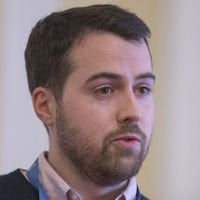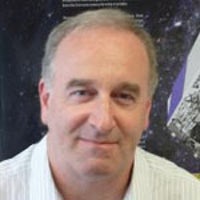Next Meeting is on Monday 25th November. It will be an open “round the table” discussion on a number of various topics. I will put up some suggestions for discussion items on the website in the next week. If anyone has a topic they would like covered just drop me a mail.
A good crowd turned out on the 11th for Dr Annabel Cartwright’s talk on the hypothesis of transfers of life and organisms between Venus & Earth 500 million years ago. She said “watch this space” re investigations on a search for biological markers in the Venusian atmosphere. I await any news with interest!
It’s good to hear of non standard hypotheses, based on the science, that challenge the established view. Whether they prove to be right or wrong they help to advance or knowledge and understanding.
Author: Kevin
Next Meeting : Monday 23rd September
Monday 23rd Sept., Dr Duncan MacLeod, Gravitational Physics Group, Cardiff University : will be talking on the subject of LIGO and Gravitational Waves.

Dr MacLeod is a Sêr Cymru COFUND Fellow in the Gravitational Physics group of the School of Physics and Astronomy. His research targets development of improved user-facing software utilities for accessing, processing, and visualising data from the second-generation of ground-based gravitational-wave detectors, primarily the Laser Interferometer Gravitational-wave Observatory (LIGO).
All are welcome. Usual time and place, The Kings Head, Abergavenny at 7:30pm.
? AAS meeting questions, 9th September ?
At our discussion meeting, last Monday, there was a lively exchange of views.
There were 3 unanswered questions asked, that I have since investigated in a bit more detail. I have posted my comments on the “General Items” page, HERE
Please note that these are my thoughts and comments. Anyone who disagrees, or can add to them, please feel free to email me HERE and I will post your responses on the website.
The 3 questions were:-
1) What are the estimates for how many generations old the sun is?
2) What is the status of the EHT (Event Horizon Telescope)? and
3) What particles are DAMA/LIBRA detecting for their recent Dark Matter detection claims?
?…………………………………………….?
Next Meeting 7:30pm, 9th September, 2019
Potential topics for our Discussion Group
Some notes on these suggested topics can be found on the downloads page HERE
If anyone has a topic they would like to explore then please bring it along, or send details to me at E-Mail
1 : Expansion of the Universe : 100 years (or so) of theory and observation.
We have gone from an expanding universe, Hubble 1929, to an accelerating universe in 1998.
What new insights or conclusions have the last 20 years brought?
| 1922:- Alexander Friedmann published a series of equations showing that the universe might be expanding and estimated what the expansion speed might be. 1927:- George Lemaitre published a paper in which he claimed that the recession of distant objects could be explained by a theory of an expanding universe. Observed a proportionality between recessional velocity and distance to nebulae and estimated a value for this constant. 1929:- Edwin Hubble confirmed observationally the existence of cosmic expansion. Determined an expansion constant from the redshifts of distant objects, known as the “Hubble Constant”. 1998:- two teams of cosmologists were observing many distant supernova. Their results seemed to suggest that, rather than the expansion rate slowing down under the influence of gravity it was actually speeding up. So, contrary to the accepted matter dominated view of the time the expansion of the universe is accelerating. They therefore deuced that there must be a repulsive force that is driving this acceleration. They termed it “Dark Energy”. 2019:- Now recent research has indicated that the rate of expansion is faster than the standard model of the universe predicts. |
Some questions that could be asked:-
What is the Standard Model, what is the Hubble constant that is being measured, what are the standard candles used for estimating distances, what is the discrepancy that threatens the standard model that the cosmologists are concerned about? Where do we go next?
2 : Dark Matter:
Did DM exist before the “Big Bang” and why is it suggested that the Milky Way disk is warped and twisted.
3 : Missions:-
The Parker Solar probe : New Horizons : James Webb Telescope : Square kilometre Array : Atomic clocks in space : Europa Clipper Mission.
4 : Evolution of Stars & Galaxies
One of the earliest stars, known as population III, found 35,000 light years away.
Using a new technique 39 ancient galaxies have been identified. The discovery doesn’t fit well with current models of the universe, much is hoped to be learnt from further research.
5 : Black Holes
A massive stellar Black Hole found that confounds current theories.
Usual time & place – 7:30pm, The Kings Head, Abergavenny
Come along and explore the cosmos. No knowledge necessary!
Meetings September 2019
Welcome to the autumn series of meetings of the Abergavenny Astronomy Society.
We start in September with:-
Monday 9th Sept., : around the table discussion. I will post a list of proposed topics next weekend along with some summary notes.
Monday 23rd Sept., Dr Duncan MacLeod, Gravitational Physics Group, Cardiff University : LIGO and Gravitational Waves.
Dr MacLeod’s research targets; development of improved user-facing software utilities for accessing, processing, and visualising data from the 2nd generation of ground-based gravitational-wave detectors, primarily LIGO.
I have also updated the “Meetings-2019 programme” page.
All are welcome. Usual time and place, The Kings Head, Abergavenny at 7:30pm.
I look forward to meeting up with everyone who can make it over the next 4 months.
Next Meeting : Monday 24th June
Professor Matt Griffin, Astronomy Instrumentation Group, Cardiff Uni. will be coming to talk to us on the subject of “Characterising Extra-solar Planets”. Brief summary:-

“Around 4,000 extra-solar planets have now been detected, and studying them is one of the most important areas of astronomical research today.
Using the technique of transit spectroscopy, it is now starting to be possible to study exoplanets and determine the chemical composition and physical constitutions in their atmosphere.
This will be an important objective for both NASA’s James Webb Space Telescope, due for launch in 2022, and ESA’s ARIEL satellite, a purpose-built exoplanet observatory, to be launched in 2028.
I’ll describe the technique and what we can learn from it, and how one day we may be able to detect the presence of life on Earth-like planets.”
Usual time & place; 7:30pm, The Kings Head, Abergavenny.
Everyone and anyone most welcome.
